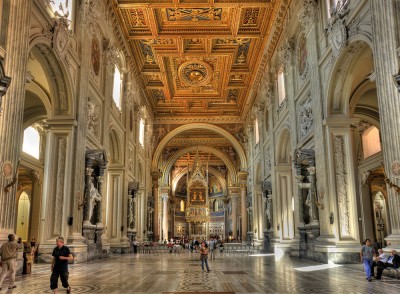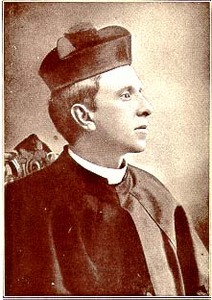Terribilis Est Locus Iste
 November 9
November 9
The Dedication of the Lateran Basilica
Today’s festival invites us, in some way, to cross the threshold of the Lateran Basilica and enter the nave, to stand in the midst of it and, with eyes wide open to things visible, begin to contemplate the invisible: the mystery of the Church, Bride of Christ and Mother of Christ’s faithful. To do this, we need not take ourselves off to Rome. It is enough, and more than enough, to enter into the wealth of antiphons, responsories, readings, hymns, and prayers that make up the splendour of today’s liturgy.
The liturgy summons us today us to make a pilgrimage of the heart. It is full of mysterious archetypes: thresholds and doors, stones and ladders, pillars and gates, fires and storms, trumpet blasts and mountains, water and blood. All of these resonate to the great central affirmation of the liturgy of the Dedication of a Church: “God is in his holy place” (Ps 67:6).
When we cross the threshold of a dedicated church, we pass into a mystic enclosure containing the uncontainable. We pass over into the space and time of God: a space filled by Him whom the heavens themselves cannot encompass, a time transcending the mean measurements of clocks and calendars. Our God, the God of Abraham, the God of Isaac, and the God of Jacob, the God of David and of Solomon, the God of Jesus Christ is not the remote and distant God of “there and then,” but the God of “here and now.” This is the wondrous realization that, dawning upon Jacob in the first reading, causes him to cry out, “How awesome is this place! This is none other than the house of God, and this is the gate of heaven” (Gen 28:17).
Today the Church professes the abiding and objective presence of God in the new and indestructible Temple which is the Body of our Lord Jesus Christ. She acclaims the Gospel in which Jesus challenges his critics, saying: “Destroy this temple, and in three days I will raise it up.” Saint John, ever the theologian, takes great care to add for our sakes, “But he spoke of the temple of his body” (Jn 2:19-21).
The Body of Christ is our Temple. To be in the Temple is to be in Christ. There we are certain of finding the Father; there we are certain of being overshadowed by the Holy Spirit. There are we surrounded by “innumerable angels in festal gathering” and by “the assembly of the first-born who are enrolled in heaven” (Heb 12:22-23). To dwell in the Temple is to share in the mystery of Christ’s priesthood, a priesthood which, like the Temple of his risen and ascended Body, endures forever. We who have been baptized into Christ have crossed the threshold of the Temple. Even more, we are that Temple.

The Temple of Christ’s Body is not the stage of great spectacle. It is the home of the little and of the poor. There, beggar and priest, harlot and levite, mingle and touch, held in the embrace of the divine hospitality. The sound that fills the living Temple is the immense symphony of the poor, the maimed, the lame, and the blind” (Lk 14:13), all clothed in their wedding garments, garments royal and priestly, woven by the Holy Spirit to adorn the Body of Christ in the presence of the Father. Here, the sacred is familiar, and the familiar, sacred. “Even the sparrow finds a home, and the swallow a nest for herself, where she may lay her young, at thy altars, O Lord of hosts” (Ps 84:3-4).
Robert Hugh Benson, a son of the Archbishop of Canterbury and celebrated convert to Catholicism of the last century wrote of the Church he came to love:
Her arms are as open to those who would serve God in silence and seclusion, as to those who dance before him with all their might. . . . There is nothing to fear for those who stand we stand; there are no precipices to be climbed any more and no torrents to be crossed; God has made all easy for those He has admitted through the Gate of Heaven that he has built upon the earth; the very River of Death itself is no more than a dwindled stream, bridged and protected on every side; the shadow of death is little more than twilight for those who look on it in the light of the Lamb.
